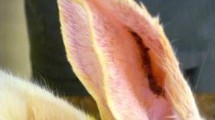Abstract
Identifying the control of cartilage regeneration is important both clinically and in tissue engineering research. A rabbit ear model was used to simulate surgery and trauma to explore the effect of perichondrial stripping on underlying cartilage in vivo. Ten rabbits (20 ears) formed four groups: two controls and two experimental groups. Group 1 served as the unoperated control group and underwent no treatment. Group 2 served as the operated control group and underwent elevation of auricular skin flaps without stripping the perichondrium. Groups 3 and 4 underwent increasing degrees of surgical insult. Group 3 underwent elevation of a skin flap with stripping of the perichondrium on both sides of the cartilage. Group 4 underwent both perichondrial stripping and the insertion of a thin silicone sheet as a barrier between the denuded cartilage and the skin flaps. At 3 months, punch biopsies of the cartilage were performed in each zone of insult, creating multiple thin sections. The results were analyzed using a computerized morphometry system. Histopathological examination of the groups revealed a regenerative layer of neocartilage which showed distinct hypercellular features of regeneration. The thickness of the new layer was proportional to the degree of the insult (p<0.01). A controlled insult to the perichondrium created a regenerative layer of cartilage; it seems that this layer of neocartilage is proportional to the insult. Further studies are in progress to clarify these findings.



Similar content being viewed by others
References
Solchaga LA, Goldberg VM, Caplan AI (2001) Cartilage regeneration using principles of tissue engineering. Clin Orth 391S:161–170
Skoog T, Ohlsen L, Sohn SA (1972) Perichondrial potential for cartilage regeneration. Scand J Plast Reconstr Surg 6:123–125
Upton J, Sohn SA, Glowacki J (1981) Neo-cartilage from transplanted perichondrium: what is it? Plast Reconstr Surg 68(2):166–172
Wright WK, Igarashi M, Greenberg D (1977) Regeneration of cartilage in the monkey auricle after subperichondrial resection. Arch Otolaryngol 103:32–34
Jeffries DJ, Rhys Evans PH (1984) Cartilage regeneration following septal surgery in young rabbits. J Laryngol Otol 98:577–583
Sohn SA, Ohlsen L (1974) Growth of cartilage from free perichondrial graft placed across a defect in a rabbit’s trachea. Plast Reconstr Surg 53:55–60
Amiel D, Coutts RD, Abel M (1985) Rib perichondrial grafts for the repair of full thickness articular defects: A morphological and biochemical study in rabbits. J Bone Jt Surg 67A:911–920
Eisenmann ML (1983) The growth potential of autograft cartilage: an experimental study. Arch Otolaryngol 10:469–472
Margulis A, Bauer BS, Alizadeh K (2004) Ear reconstruction after auricular chondritis secondary to ear piercing. Plast Reconstr Surg 113(2):768–769
Lack W, Bosch P, Lintner F (1986) Influence of trypsin on the regeneration of hyaline articular cartilage. Acta Orthop Scand 57(2):123–125
Skoog V, Widenfalk B, Ohlsen L (1990) The effect of growth factors and synovial fluid on chondrogenesis in the perichondrium. Scand J Plast Reconstr Surg Hand Surg 24:89
Lee KH, Song SU, Hwang TS et al (2001) Regeneration of hyaline cartilage by cell mediated gene therapy using transforming growth factor beta 1-producing fibroblasts. Hum Gene Ther 12(14):1805–1813
Blaney Davidson EN, Schartstuhl A, Vitters EL, van der Kraan PM, van den Berg WB (2005) Reduced transforming growth factor beta signaling in cartilage of old mice: role in impaired repair capacity. Arthritis Res Ther 7(6):R1338–R1347
Hiraide A, Yokoo N, Xin KQ, Okuda K, Mizukami H, Ozawa K, Saito T (2005) Repair of articular cartilage defect by intra-articular administration of basic fibroblast growth factor gene using adeno associated virus vector. Hum Gene Ther 16(12):1413–1421
Boenisch M, Mink A (2000) Clinical and histological results of septoplasty with resorbable implant. Arch Otolaryngol Head Neck Surg 126(11):1373–1377
Brent B (1998) Technical advances in ear reconstruction with autogenous rib cartilage grafts: personal experience with 1200 cases. Plast Reconstr Surg 102(4):319–334
Duynstee MLG, Verwoerd-Verhoef HL, Verwoerd CDA et al (2002) The dual role of perichondrium in cartilage wound healing. Plast Reconstr Surg 110(4):1073–1079
Sela J, Shani J, Borut-Mintz S et al (1996) A quantitative morphometric study of the kinetics of tissue regeneration after administration of cisplatin. Anticancer Drugs 7(5):579–585
Author information
Authors and Affiliations
Corresponding author
Rights and permissions
About this article
Cite this article
Ad-El, D.D., Selah, J., Goshen, G. et al. Induction of cartilage growth in a rabbit ear model: a pilot study. Eur J Plast Surg 28, 513–516 (2006). https://doi.org/10.1007/s00238-006-0048-z
Received:
Accepted:
Published:
Issue Date:
DOI: https://doi.org/10.1007/s00238-006-0048-z




